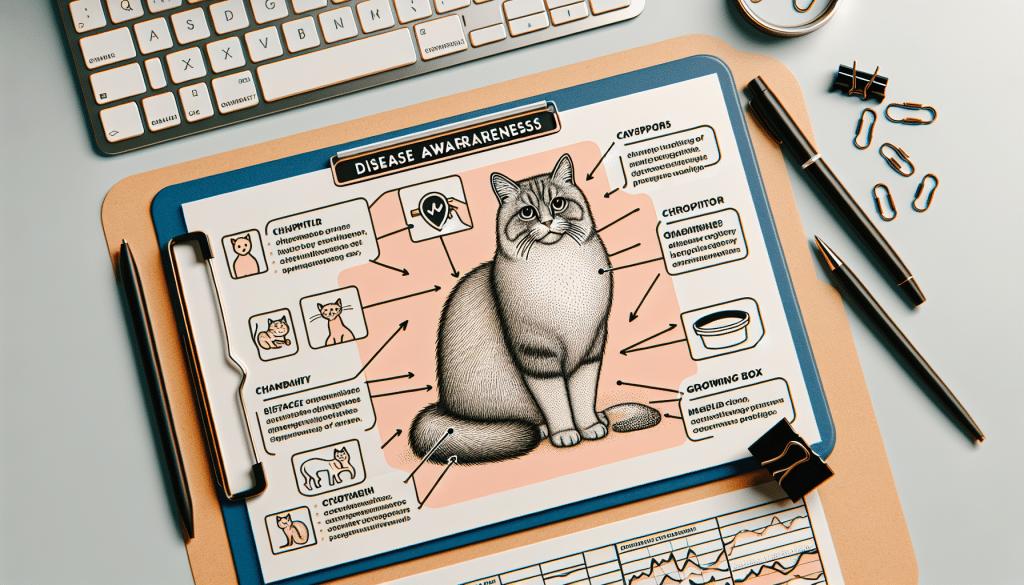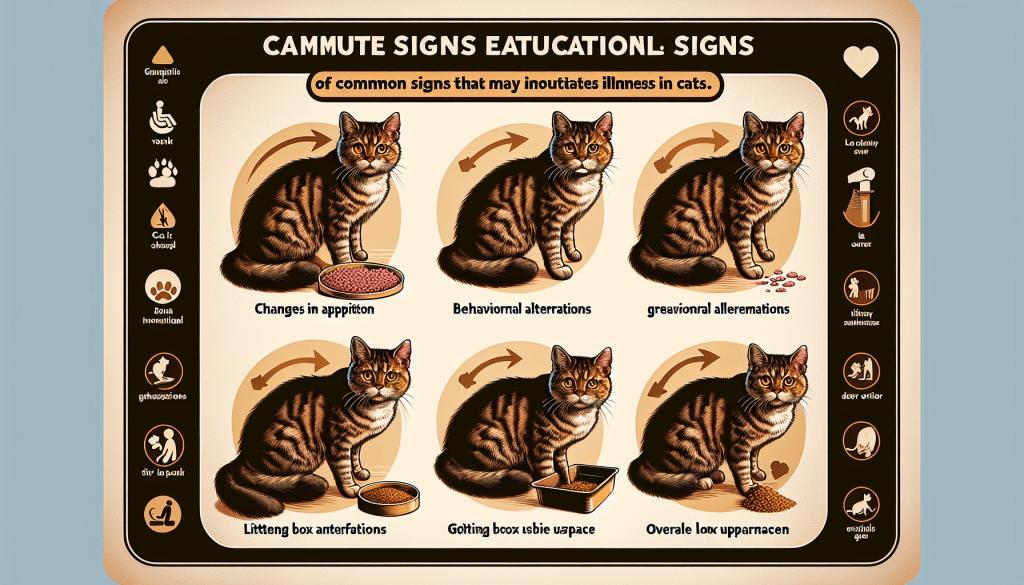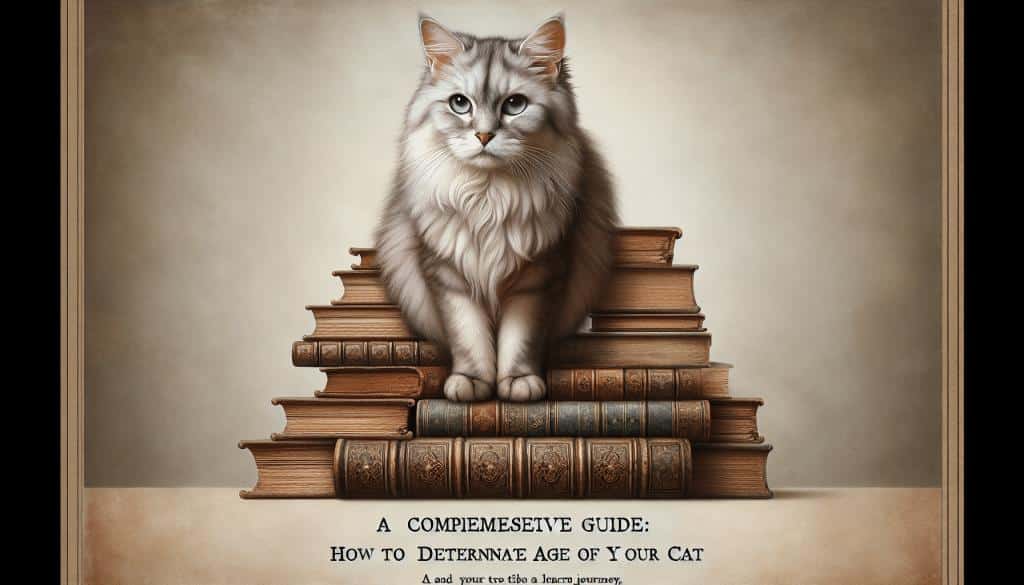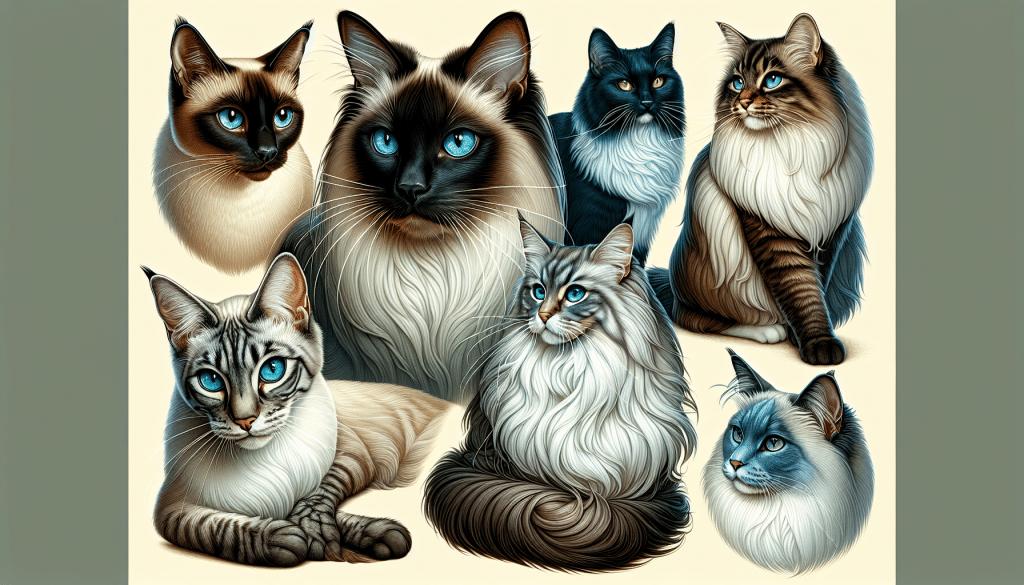So you’ve got a feline friend that you adore, but how do you know if they’re feeling under the weather? Cats can be masters at hiding their illnesses, making it crucial for you, as their devoted owner, to keep a close eye on their behavior and look out for any signs that may indicate they’re not feeling their best. In this article, we’ll discuss some common indicators that your cat may be sick, helping you ensure their well-being and provide them with the care they need.

Changes in Eating Habits
Refusal to eat or decreased appetite
If you notice that your cat is refusing to eat or has a decreased appetite, it could be a sign that something is wrong. Cats are known for their love of food, so a sudden change in their eating habits should not be ignored. It could be due to a variety of reasons, such as dental issues, gastrointestinal problems, or even stress. If your cat refuses to eat for more than a day or two, it is essential to consult with a veterinarian to determine the underlying cause and provide necessary treatment.
Overeating
On the flip side, if your cat suddenly starts overeating and constantly begs for food, it could be cause for concern. Overeating can lead to obesity and other health issues in cats, just as it does in humans. It may be a sign of an underlying medical condition such as hyperthyroidism or diabetes. Monitoring your cat’s food intake and ensuring they receive a balanced diet is crucial for maintaining their health. If you notice excessive overeating, consult with a veterinarian to rule out any medical conditions and establish a proper feeding routine.
Increased thirst or water consumption
If you find that your cat is drinking more water than usual or showing an increased thirst, it could indicate an underlying health problem. Some conditions like diabetes, kidney disease, or hyperthyroidism can cause excessive thirst in cats. Keep an eye on your cat’s water intake and make sure they have access to fresh water at all times. If you notice a significant increase in thirst or your cat is constantly seeking out water sources, consult with a veterinarian to evaluate any potential underlying medical issues.
Behavioral Changes
Lethargy or lack of activity
Cats are typically known for their curious and active nature. If your cat suddenly becomes lethargic, it could be a sign that something is amiss. Lethargy can occur due to various reasons, such as illness, pain, or even emotional distress. Pay attention to changes in your cat’s energy levels and behavior. If they are no longer engaging in their usual playtime activities or seem unusually tired for an extended period, it is crucial to seek veterinary advice to determine the underlying cause.
Aggression or irritability
Cats are generally independent and reserved animals, but if your cat starts displaying aggressive or irritable behavior out of the blue, it may be a red flag. Aggression can be a manifestation of underlying health issues, pain, or even stress in cats. It is essential to observe any changes in your cat’s behavior, especially if they become hostile towards family members or other pets. Consult with a veterinarian to rule out any potential medical issues and explore behavioral interventions to address their aggression or irritability.
Uncharacteristic hiding or isolation
Cats are known for their occasional hiding and seeking solitude, but if your cat starts isolating themselves more frequently or in unusual places, they may be trying to communicate distress. Cats may hide to escape perceived threats, pain, or discomfort. If you notice a sudden change in your cat’s hiding behavior, it is essential to pay attention and investigate the cause. Reach out to a veterinarian for advice on addressing this behavior and ensuring your cat’s wellbeing.
Neglecting grooming or over-grooming in certain areas
Cats are famously known for their pristine grooming habits, so any significant change in their grooming behavior should be taken seriously. If your cat starts neglecting their grooming routine, leaving their coat dull, patchy, or rough, it could be indicative of an underlying health issue or pain. On the other hand, excessive grooming in specific areas can lead to hair loss and irritated skin. Keep an eye on your cat’s grooming habits, and consult with a veterinarian if you notice any abnormalities to identify and address the root cause of the behavior.

Physical Appearance
Unexplained weight loss or gain
One of the easiest signs to notice in your cat’s physical appearance is a sudden change in weight. Significant weight loss or gain without any apparent reason can be a cause for concern. Weight loss can indicate various health issues such as hyperthyroidism, diabetes, or gastrointestinal problems. Conversely, weight gain can be associated with overfeeding, lack of exercise, or underlying medical conditions. Regularly monitor your cat’s body condition, and consult with a veterinarian if you notice any unexplained weight changes to determine the cause and develop a suitable plan of action.
Dull, patchy, or rough coat
A cat’s coat is often a reflection of their overall health and well-being. If you observe that your cat’s coat has become dull, patchy, or rough, it may indicate an underlying health issue. A healthy cat should have a smooth, shiny coat. Changes in the coat’s texture or appearance can be a result of numerous factors like nutritional deficiencies, skin infections, allergies, or hormonal imbalances. Regularly groom your cat and pay attention to any changes in their coat. Consult with a veterinarian if you notice any abnormalities to diagnose and treat the underlying cause.
Loss of fur
If you notice that your cat is experiencing excessive hair loss, it could be a sign of an underlying medical issue or a grooming problem. Cats may excessively groom themselves due to stress, skin irritations, allergies, or even parasites. This excessive grooming can lead to hair loss, commonly seen in areas such as the belly, legs, or tail. If your cat exhibits hair loss that is beyond normal shedding, consult with a veterinarian to identify the underlying cause and provide appropriate treatment.
Changes in Litter Box Usage
Frequent urination
Cats are known for their regular and consistent litter box usage. If you notice that your cat is urinating more frequently than usual or in larger amounts, it may be cause for concern. Frequent urination can indicate various health problems, including urinary tract infections, kidney issues, or diabetes. Monitor your cat’s litter box habits and take note of any changes in urination patterns. If there is a significant increase in frequency or volume, consult with a veterinarian for a proper diagnosis and necessary treatment.
Avoiding the litter box altogether
On the other hand, if your cat suddenly starts avoiding the litter box and urinating or defecating outside of it, it may indicate an underlying issue. Cats are generally clean animals and prefer to use their designated litter box. Avoiding the litter box can be a sign of discomfort, pain, or an underlying medical condition such as urinary tract infections, bladder stones, or gastrointestinal problems. If your cat starts exhibiting this behavior, consult with a veterinarian to identify the cause and address any potential health concerns.
Noticeable changes in stool or urine
Pay close attention to your cat’s stool and urine. Any noticeable changes in color, consistency, or smell can be a sign of an underlying health issue. Diarrhea, constipation, or bloody stools can indicate gastrointestinal problems, dietary sensitivities, or infections. Similarly, changes in the urine’s color, odor, or frequency can be indicative of urinary tract infections or kidney issues. Regularly check your cat’s litter box for any abnormalities and consult with a veterinarian if you notice any significant changes to ensure proper diagnosis and treatment.

Vomiting and Diarrhea
Repeated vomiting
Occasional vomiting can be normal for cats, especially if they have consumed something disagreeable or ingested hair during grooming. However, repeated vomiting, particularly when accompanied by other symptoms, should not be overlooked. Persistent vomiting can indicate gastrointestinal issues, dietary sensitivities, or even underlying systemic diseases. If your cat experiences recurrent vomiting episodes, consult with a veterinarian to investigate the root cause and provide appropriate treatment.
Continuous or severe bouts of diarrhea
Diarrhea is never a pleasant experience for cats or their owners. Continuous or severe bouts of diarrhea should be a cause for concern. Diarrhea can occur due to various reasons, including dietary indiscretions, gastrointestinal infections, or inflammatory bowel disease. If your cat is experiencing persistent or severe diarrhea, it is crucial to consult with a veterinarian for proper evaluation and treatment to prevent dehydration and further complications.
Presence of blood in vomit or stool
Finding blood in your cat’s vomit or stool can be alarming. The presence of blood may indicate underlying gastrointestinal problems, such as ulcers, inflammation, or even intestinal blockage. It is essential to seek veterinary attention immediately if you notice blood in your cat’s vomit or stool. With prompt intervention and proper diagnosis, the underlying cause can be addressed, ensuring your cat’s health and well-being.
Respiratory Issues
Coughing
If you hear your cat coughing, it may be an indication of a respiratory issue. Coughing in cats can be caused by various factors, including allergies, infections, or even heart disease. Monitor your cat’s coughing episodes and consult with a veterinarian to identify the cause and provide appropriate treatment.
Breathing heavily
If your cat starts breathing heavily or panting excessively, it may signal an underlying problem. Cats normally breathe quietly and smoothly, and any noticeable changes in their breathing patterns should be taken seriously. Heavy breathing can be a result of various conditions, including respiratory infections, heart disease, or even heatstroke. If your cat displays abnormal breathing patterns, seek immediate veterinary care for a proper diagnosis and treatment.
Frequent sneezing
Sneezing is a common occurrence in cats, especially if they encounter irritants or have mild respiratory infections. However, if your cat starts sneezing excessively or frequently, it could be a sign of underlying allergies, infections, or even nasal polyps. Keep an eye on your cat’s sneezing episodes, and if it becomes persistent or is accompanied by other symptoms, consult with a veterinarian to identify the cause and determine appropriate treatment.
Changes in Mobility
Visible discomfort when walking
Cats are agile and graceful creatures, so if you notice your cat displaying signs of discomfort or pain when walking, it may be indicative of an issue. Visible discomfort can manifest as limping, favoring one leg over the other, or even reluctance to put weight on certain limbs. These symptoms can be caused by various conditions, including joint problems, injuries, or arthritis. It is crucial to observe your cat’s mobility and consult with a veterinarian to assess the cause and develop a suitable plan for managing their discomfort.
Limping
If your cat begins limping or favoring a specific leg, it may be a sign of a joint problem, injury, or other underlying health issues. Cats are known for their agility, and any visible limping or reluctance to use a limb should be taken seriously. Monitor your cat’s mobility and seek veterinary advice to pinpoint the cause and provide appropriate treatment.
Hesitation to jump or climb
Cats are natural climbers and jumpers, so if your cat suddenly hesitates to jump or climb, it may signal a problem. Reluctance to engage in activities they previously enjoyed could indicate pain, joint issues, or even fatigue. Pay attention to any changes in your cat’s activity levels and consult with a veterinarian to identify and address the underlying cause.
Stiffness or immobility
Another sign to watch out for is stiffness or immobility in your cat. Cats typically exhibit fluid and effortless movements, so any signs of stiffness or difficulty when performing actions such as stretching or jumping should raise concern. Stiffness and immobility can be indicative of joint problems, arthritis, or other underlying health conditions. Consulting with a veterinarian will help determine the cause and provide suitable treatment options to improve your cat’s mobility.
Eye or Ear Discharges
Excessive tearing or discharges from eyes
If you notice excessive tearing or abnormal discharges from your cat’s eyes, it may indicate an eye issue or infection. Cats can develop various eye conditions, including conjunctivitis, corneal ulcers, or even glaucoma. Monitor your cat’s eyes for any changes or discharges, and consult with a veterinarian to assess the problem and provide appropriate treatment.
Cloudy or discolored eyes
If your cat’s eyes appear cloudy or discolored, it may signal an underlying health problem. Cloudy eyes in cats can be a result of cataracts, glaucoma, or inflammation. Discoloration of the eyes can indicate jaundice or other systemic issues. Regularly check your cat’s eyes and seek veterinary attention if you notice any abnormalities to ensure early detection and necessary intervention.
Frequent scratching of ears
Cats typically groom their ears, but excessive scratching or shaking of the head may indicate an ear problem. Cats can develop ear infections, ear mites, or even allergies that cause discomfort and irritation. Keep an eye on your cat’s scratching behavior and observe if they exhibit other signs such as sensitivity around the ears or ear discharge. If you notice any of these symptoms, consult with a veterinarian to diagnose and treat the underlying ear condition.
Unpleasant smell from ears
A foul or unpleasant smell emanating from your cat’s ears may indicate an ear infection or other ear-related issues. Cats are prone to developing infections, ear mites, or even yeast infections in their ears. Regularly check your cat’s ears for any odor or discharge and consult with a veterinarian to identify and address the cause of the unpleasant smell.
Changes in Vocalization
Excessive meowing or yowling
Cats communicate through various vocalizations, but if your cat starts excessively meowing or yowling, it may be an indication of an underlying issue. Excessive vocalization can be caused by pain, discomfort, or even cognitive decline in older cats. Monitor your cat’s vocalization patterns and consult with a veterinarian to evaluate any potential medical concerns or behavioral interventions.
Prolonged purring
While purring is often associated with contentment and relaxation, prolonged or excessive purring can be a sign that something is amiss. Cats may purr to comfort themselves when they are in pain or distress. If your cat is constantly purring even in situations where they would typically be silent, it is essential to seek veterinary advice to identify and address any underlying issues.
Changes in the cat’s usual voice
If you notice any changes in your cat’s voice, such as hoarseness, raspiness, or a complete loss of voice, it may indicate an issue with their throat or respiratory system. Changes in vocalization can occur due to conditions like laryngitis, respiratory infections, or even growths in the throat. Monitor your cat’s voice, and if you notice any significant changes, consult with a veterinarian for a proper evaluation and necessary treatment.
Bad Breath or Oral Issues
Severe bad breath
It’s no secret that a cat’s breath is not always the freshest, but if your cat’s breath becomes exceptionally foul, it could be a sign of oral health issues. Bad breath can be caused by various dental problems, including gum disease, tooth decay, or infections. Regularly check your cat’s mouth for any signs of redness, swelling, or visible dental issues. Consult with a veterinarian for a dental examination and proper oral care recommendations if you notice severe bad breath in your cat.
Excessive drooling
While occasional drooling can be normal, excessive drooling in cats should be a cause for concern. Excessive drooling can be an indication of oral problems, such as dental diseases, mouth sores, or even foreign objects stuck in the mouth. Monitor your cat’s drooling patterns and observe if there are any accompanying symptoms, such as difficulty eating or pawing at the mouth. If excessive drooling persists, consult with a veterinarian to evaluate and address the underlying oral issues.
Sores or inflammation in the mouth
If you notice any sores or inflammation in your cat’s mouth, it may suggest oral health problems. Cats can develop ulcers, gingivitis, or even tumors in their mouth, resulting in discomfort and pain. Regularly inspect your cat’s mouth for any abnormalities and consult with a veterinarian to determine the underlying cause and provide appropriate treatment.
In conclusion, being aware of changes in your cat’s behavior, physical appearance, litter box usage, and overall health is crucial for their well-being. By observing and addressing any concerning signs, you can ensure that your furry friend receives the necessary care and attention they deserve. Remember, if you notice any significant changes or abnormalities in your cat’s health, consult with a veterinarian for proper diagnosis and treatment. Your attentive care and prompt intervention can make all the difference in maintaining your cat’s health and happiness.



